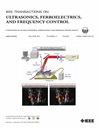Lung Ultrasound Spectroscopy Applied to the Differential Diagnosis of Pulmonary Diseases: An In Vivo Multicenter Clinical Study
IF 3
2区 工程技术
Q1 ACOUSTICS
IEEE transactions on ultrasonics, ferroelectrics, and frequency control
Pub Date : 2024-09-05
DOI:10.1109/TUFFC.2024.3454956
引用次数: 0
Abstract
Lung ultrasound (LUS) is an important imaging modality to assess the state of the lung surface. However, current LUS approaches are based on subjective interpretation of imaging artifacts, which results in poor specificity as quantitative evaluation lacks. The latter could be improved by adopting LUS spectroscopy of vertical artifacts. Indeed, parameterizing these artifacts with native frequency, bandwidth, and total intensity (肺部超声波光谱学应用于肺部疾病的鉴别诊断:一项体内多中心临床研究。
肺部超声(LUS)是评估肺表面状况的一种重要成像方式。然而,目前的 LUS 方法基于对成像伪影的主观判读,缺乏定量评估,因此特异性较差。通过对垂直伪影进行 LUS 光谱分析,可以改善后者。事实上,用原生频率、带宽和总强度(ITOT)对这些伪影进行参数化处理已显示出在区分肺纤维化(PF)方面的潜力。在这项研究中,我们获得了 114 名患者的射频(RF)数据。这些数据(代表了全球最大的 LUS 射频数据集)是利用 ULtrasound 高级开放平台的多频方法获得的。凸面探头(CA631)和线性探头(LA533)(百胜,意大利佛罗伦萨)分别以三个(2、3、4 MHz)和四个(3、4、5、6 MHz)成像频率获取射频数据。对心源性肺水肿(CPE)、肺炎或 PF 患者检测到的垂直伪影进行了多频分析。这些伪影以上述三个参数为特征,其平均值用于将每位患者投射到一个多达三个维度的特征空间中。二元分类器用于评估这三个平均特征在区分 CPE、肺炎和 PF 患者方面的性能。使用线性探针采集多频数据,在这些疾病的鉴别诊断中准确率高达 85.43%(凸探针的最高准确率为 74.51%)。此外,结果表明平均 ITOT(本身或与其他特征相结合)在提高 LUS 特异性方面具有很大潜力。
本文章由计算机程序翻译,如有差异,请以英文原文为准。
求助全文
约1分钟内获得全文
求助全文
来源期刊
CiteScore
7.70
自引率
16.70%
发文量
583
审稿时长
4.5 months
期刊介绍:
IEEE Transactions on Ultrasonics, Ferroelectrics and Frequency Control includes the theory, technology, materials, and applications relating to: (1) the generation, transmission, and detection of ultrasonic waves and related phenomena; (2) medical ultrasound, including hyperthermia, bioeffects, tissue characterization and imaging; (3) ferroelectric, piezoelectric, and piezomagnetic materials, including crystals, polycrystalline solids, films, polymers, and composites; (4) frequency control, timing and time distribution, including crystal oscillators and other means of classical frequency control, and atomic, molecular and laser frequency control standards. Areas of interest range from fundamental studies to the design and/or applications of devices and systems.

 求助内容:
求助内容: 应助结果提醒方式:
应助结果提醒方式:


